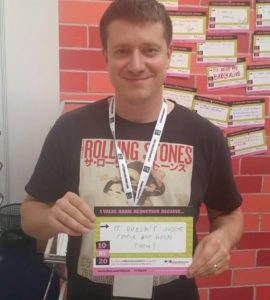
Tell me a bit about the Rights Reporter Foundation and its involvement in harm reduction in Hungary.
The Rights Reporter Foundation (RRF) is a relatively new organization. I founded it two years ago with István Gábor Takács, with whom I have been working in the field of harm reduction and drug policy reform for more than ten years. Before starting it, we both worked for the Hungarian Civil Liberties Union (HCLU). RRF is a human-rights organization that aims to improve evidence-based policymaking by educating the public and giving vulnerable people a voice. We also train other NGOs and activists to work with the media, and to produce and use videos for advocacy.
Because we’ve produced hundreds of short online films about key issues, events, and organizations in the field, we’re often seen as the chroniclers of the region’s harm-reduction movement.
We’re best known for the website Drugreporter (drugreporter.net), which I started at HCLU in 2004 and which features a unique online video library on human rights and drug policy in central and eastern Europe. Because we’ve produced hundreds of short online films about key issues, events, and organizations in the field, we’re often seen as the chroniclers of the region’s harm-reduction movement. In Hungary, we were on the frontlines of the fight for harm reduction when the two largest needle and syringe programs (NSPs) had to shut down due to the political climate and a lack of funding.
Why has funding for harm reduction decreased in Hungary?
In 2010, the government shifted its drug policy from a harm-reduction approach to an abstinence-oriented approach. They increased penalties for drug possession and adopted a new national drug strategy in 2013 with the stated aim of creating a drug-free Hungary by 2020. National funding for prevention programs, harm reduction and treatment services steadily decreased between 2009 and 2012, falling from 752 million forints to 129 million forints (EUR 418,000) annually. During the same period, we witnessed a major change in the drug market, as most people who injected drugs shifted from heroin to new psychoactive substances. Since the effects of these new substances wear off more quickly, the frequency of injection has gone up. That means that more needles actually need to be distributed to prevent the spread of HIV and hepatitis C (Table 1).

Hepatitis C is on the rise among people who inject drugs, with the prevalence doubling between 2011 and 2014.
In 2014 the two largest NSPs closed down in Budapest. Unfortunately, the consequences of these changes have been all too clear: hepatitis C is on the rise among people who inject drugs, with the prevalence doubling between 2011 and 2014, from 24% to 50%. The lack of funding is only part of the problem. The other part is the ongoing conflicts with some of the local city councils. I feel that harm- reduction service providers are too often targeted as scapegoats and unjustly blamed for being a public nuisance and contributing to drug-related litter on the streets.
Which strategies seem most promising for increasing harm-reduction funding there?
We’ve tried many different things. We’ve sent letters to the government and initiated consultations with mayors; we’ve invited EU and UN experts to talk to our government officials; we’ve had professionals from Romania talk about the HIV epidemic caused by a lack of harm reduction there – all in vain.
We also launched Room in the Eight, a local advocacy campaign in the most affected district of Budapest, which was very successful in terms of media coverage and public engagement but did nothing to change government policy. It’s obvious that the opposition to harm reduction is not based on any lack of awareness – it’s ideological. All we can do is keep trying.
Further links and information:
Global and regional harm reduction goals
WHO, UNODC, UNAIDS technical guide for countries to set targets for universal access to HIV prevention, treatment and care for injecting drug users:
“To successfully address HIV where injecting drug use occurs, countries should prioritise implementing needle & syringe programmes (NSP) and evidence-based drug dependence treatment (specifically opioid substitution therapy [OST]).”1
European WHO Regional Targets, to be achieved by 2020:
“A comprehensive package of harm reduction services to all persons who inject drugs, including:
- At least 200 syringes distributed per PWID per year
- At least 40% of opioid dependent PWID receive opioid substitution therapy − HBV and HAV vaccination
90% of PWID receiving targeted information, education and communication provided by NSPs, drug treatment service sites (including OST) and other services targeting PWID.”2
Global Health Sector Strategy on viral hepatitis 2016-2021:
“Priority actions for countries: Implement a comprehensive package of harm reduction services, where appropriate, based on the WHO package of evidence-based harm reduction interventions for people who inject drugs…Address legal and institutional barriers to the provision of harm reduction services.”3
Hepatology, Medicine and Policy is now accepting submissions on this and related issues. For more information, visit: www.hmap.biomedcentral.com.
Comments